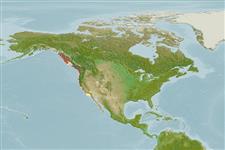>
Perciformes/Cottoidei (Sculpins) >
Cottidae (Sculpins)
Etymology: Artedius: Petrus (Peter) Artedi, (10 Mar.) 1705-35 (28 Sep.), a son of a clergyman from Anundsjö named Olaus Arctaedius, in the northern part of Sweden.In 1729 he changed his name from Arctaedius to Arctædi, a name still later simplified to Artedi (Ref. 45335); harringtoni: Named for Mark W. Harrington, President of the University of Washington (Ref. 6885).
More on author: Starks.
Environment: milieu / climate zone / depth range / distribution range
ນິເວດວິທະຍາ
ສັດທະເລ ອາໄສຢູ່ໃກ້ໜ້າດິນໃຕ້ພື້ນທ້ອງນ້ຳ; ລະດັບຄວາມເລິກ 1 - 21 m (Ref. 2850). Temperate; 58°N - 32°N, 155°W - 118°W
Eastern Pacific: Kodiak Island, Alaska to San Miguel Island, southern California, USA.
ຂະໜາດ / ນ້ຳໜັກ / Age
Maturity: Lm ? range ? - ? cm
Max length : 10.0 cm TL ຕົວຜູ້/ບໍ່ມີເພດ; (Ref. 2850)
ຄີ (ໜາມ)ແຂງຢູ່ຫຼັງປາ (ທັງໝົດ): 9 - 10; ຄີຫຼັງຂອງປາ (ຄີອ່ອນ) (ທັງໝົດ): 16-18; ຄີ(ໜາມ) ແຂງຢູ່ຄີກົ້ນປາ
ກຸ່ມປາກະດູກແຂງ
ຄວາມຖີ່ຂອງກຸ່ມຖ່າຍທອດພັນ
ປາທີ່ມີການເຄື່ອນຍ້າຍຈາກທະເລໄປຫານ້ຳຈືດ ແລະນ້ຳຈືດຫາທະເລ
ປາທີ່ມີການເຄື່ອນຍ້າຍຈາກທະເລແລະໄປໄຂ່ຢູ່ນ້ຳຈືດ
ຄີກົ້ນຂອງປາ
ສັດທີ່ມີກະດູກສັນຫັຼງ
ການຖ່າຍທອດທາງກຳມະພັນຈາກພໍ່ແມ່ຫາລູກ 0; ຄີກົ້ນຂອງປາ: 10 - 14. Pelvic fins small.
Found in intertidal and subtidal rocky areas, around pilings (Ref. 2850). Males are territorial (Ref. 6885). Sexual dimorphism is remarkable (Ref. 74407). Males guard eggs (Ref. 74407).
Life cycle and mating behavior
ການຈະເລີນເຕັມໄວ | ການສືບພັນ | ການວາງໄຂ່ | ໄຂ່ | ຄວາມດົກຂອງໄຂ່ປາ | ຕົວອ່ອນ
Males guard clutches of eggs and are quite territorial (Ref. 74407). The following account of mating behaviour comes from Ragland et.al. (1978): observed from an aquarium, courtship began 'when a gravid female approached a shelter occupied by a male. The male, which was not guarding eggs, responded by rolling its head in a circle and flaring the orange branchiostegal membranes. The cirri were not moved or deployed in any obvious fashion.
The female either ignored the male or responded by snapping the head horizontally several times in rapid succession and occasionally quivering. Once she entered the nest, the male often extruded its pene and performed bouts of a fanning display similar to those of other cottids (Ref. 205). The female left the nest shortly after laying eggs.'
Occurrence of intromission was not observed from this study due to technical problems. However, eggs stripped from gravid females developed and hatched after 11-15 days in the absence of a male, thereby supporting the hypothesis that internal fertilization had occurred.
Eschmeyer, W.N., E.S. Herald and H. Hammann, 1983. A field guide to Pacific coast fishes of North America. Boston (MA, USA): Houghton Mifflin Company. xii+336 p. (Ref. 2850)
IUCN Red List Status (Ref. 130435)
Threat to humans
Harmless
Human uses
ຕູ້ປາ: ບ່ອນວາງສະແດງສັນນ້ຳຂອງລັດ
ຂໍ້ມູນຕື່ມອີກ
ເອກະສານອ້າງອີງການລ້ຽງສັດນ້ຳຂໍ້ມູນການລ້ຽງສັດນ້ຳສາຍພັນກຳມະພັນElectrophoresesການຖ່າຍທອດທາງກຳມະພັນຈາກພໍ່ແມ່ຫາລູກພະຍາດການປຸງແຕ່ງNutrientsMass conversion
ຜູ້ຮ່ວມມືຮູບStamps, Coins Misc.ສຽງຫອຍມີພິດຊະນິດນຶ່ງທີ່ອາໄສໃນທະເລຄວາມໄວປະເພດການລອຍເນື້ອທີ່ເຫືອກOtolithsສະໝອງວິໄສທັດ
ເຄື່ອງມື
Special reports
Download XML
ແຫຼ່ງອີນເຕີເນັດ
Estimates based on models
Preferred temperature (Ref.
123201): 7.1 - 12.8, mean 10.1 °C (based on 178 cells).
Phylogenetic diversity index (Ref.
82804): PD
50 = 0.5312 [Uniqueness, from 0.5 = low to 2.0 = high].
Bayesian length-weight: a=0.00676 (0.00300 - 0.01523), b=3.17 (2.98 - 3.36), in cm total length, based on LWR estimates for this (Sub)family-body shape (Ref.
93245).
ຊັ້ນເຂດຮ້ອນ (Ref.
69278): 3.4 ±0.52 se; based on food items.
ຄວາມຢືດຢຸ່ນ (Ref.
120179): ຂະໜາດກາງ, ປະຊາກອນຕຳ່ສຸດທີ່ໃຊ້ເວລາສອງເທົ່າ 1.4 - 4.4 ປີ (Preliminary K or Fecundity.).
Fishing Vulnerability (Ref.
59153): Low vulnerability (10 of 100).
Nutrients (Ref.
124155): Calcium = 142 [51, 339] mg/100g; Iron = 0.46 [0.21, 1.08] mg/100g; Protein = 17.3 [15.0, 19.5] %; Omega3 = 0.602 [0.229, 1.706] g/100g; Selenium = 7.75 [3.04, 20.40] μg/100g; VitaminA = 35.5 [9.1, 131.4] μg/100g; Zinc = 0.973 [0.600, 1.752] mg/100g (wet weight);
